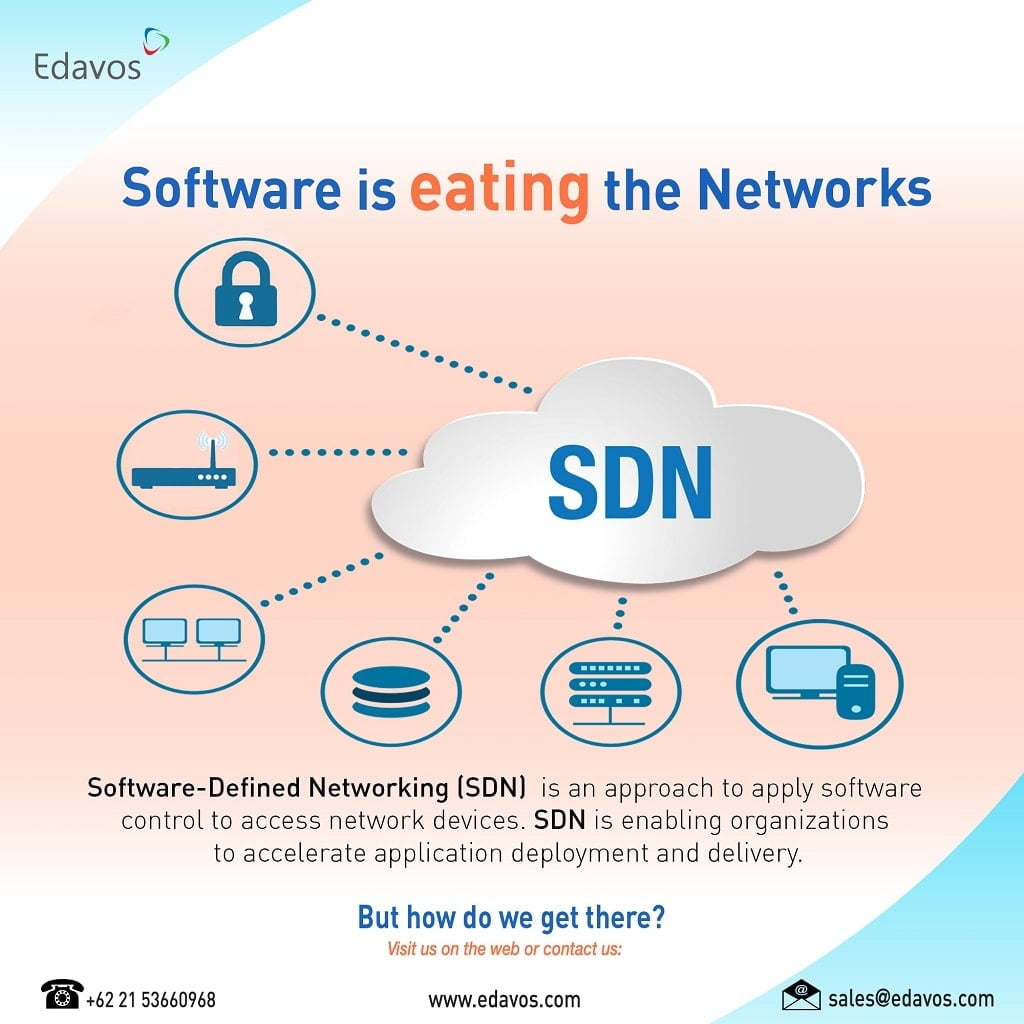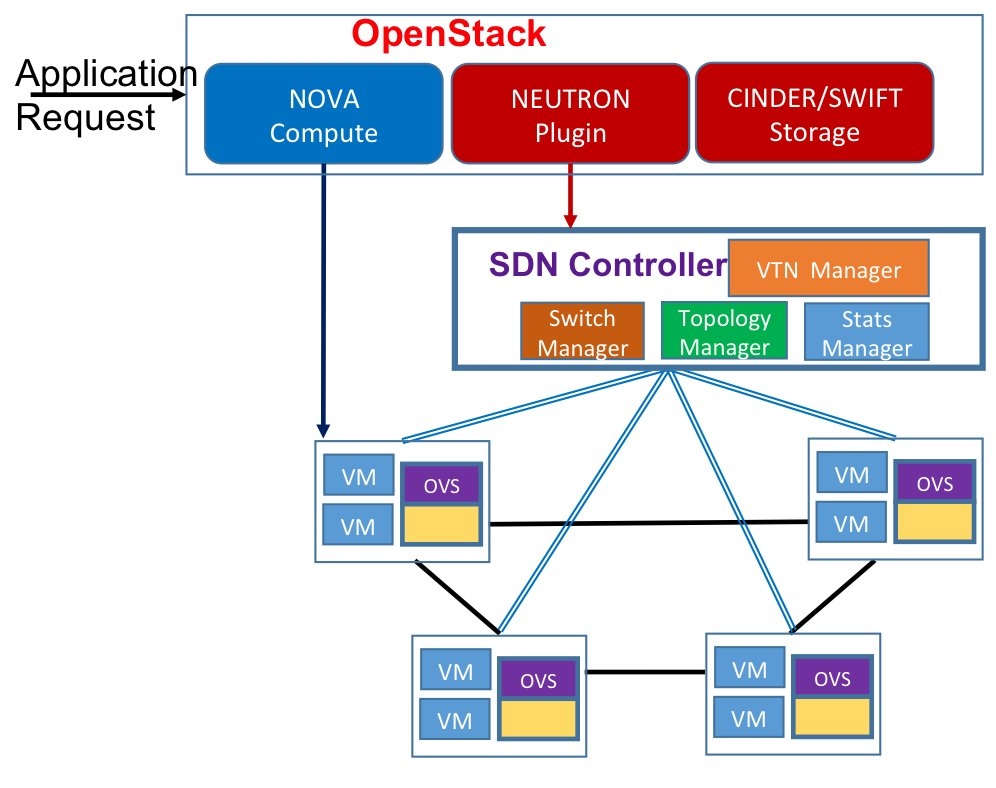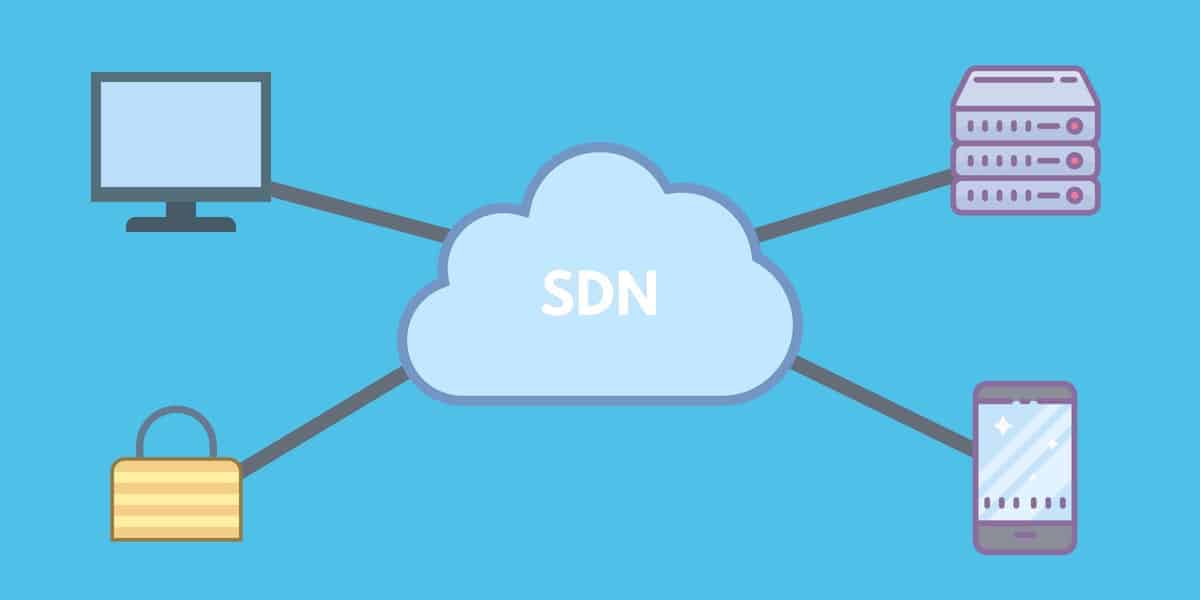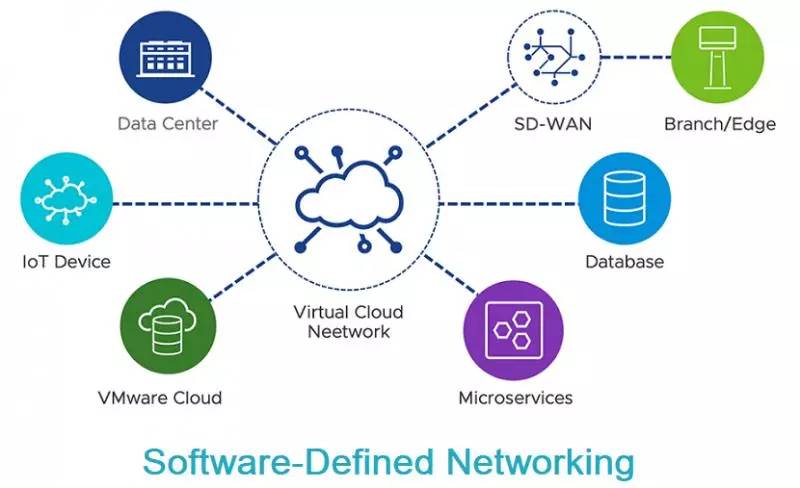What is Software-Defined Networking in Cloud Computing?
Software-defined networking (SDN) in cloud computing refers to a network architecture that decouples the control plane from the data plane, enabling centralized management and programmability of the network infrastructure. SDN simplifies network configuration, increases agility, and improves security in cloud environments. It allows administrators to control and manage network behavior through software applications, making it easier to adapt to changing business needs and application requirements.
In traditional networking approaches, network devices such as switches and routers have tightly integrated control and data planes, making it difficult to modify network behavior without manual intervention. SDN, on the other hand, introduces a centralized control plane that communicates with the data plane using standardized protocols, allowing for more flexible and dynamic network management. This separation of concerns also enhances network security by enabling better visibility and control over network traffic.
SDN in cloud environments offers several benefits, including improved network flexibility, cost efficiency, and security. By abstracting the network control functions, SDN enables administrators to rapidly provision and reconfigure network resources, reducing the time and effort required to manage complex network topologies. Additionally, SDN can help reduce capital and operational expenses by optimizing network utilization and automating routine tasks. Finally, SDN’s centralized management and programmability can enhance network security by enabling administrators to implement fine-grained access control policies, detect and respond to security threats more quickly, and maintain consistent security postures across the network infrastructure.
How SDN Differs from Traditional Networking Approaches
Software-defined networking (SDN) represents a significant departure from traditional networking approaches in cloud environments. In traditional networking, the control plane and data plane are tightly integrated within network devices, making it challenging to modify network behavior without manual intervention. SDN, however, decouples the control plane from the data plane, enabling centralized management and programmability of the network infrastructure.
In traditional networking, network devices such as switches and routers have proprietary operating systems and command-line interfaces, making it difficult to manage and configure them at scale. SDN, on the other hand, introduces a centralized control plane that communicates with the data plane using standardized protocols, allowing for more flexible and dynamic network management. This separation of concerns also enhances network security by enabling better visibility and control over network traffic.
SDN offers several benefits over traditional networking approaches, including improved network flexibility, security, and cost efficiency. By abstracting the network control functions, SDN enables administrators to rapidly provision and reconfigure network resources, reducing the time and effort required to manage complex network topologies. Additionally, SDN can help reduce capital and operational expenses by optimizing network utilization and automating routine tasks. Finally, SDN’s centralized management and programmability can enhance network security by enabling administrators to implement fine-grained access control policies, detect and respond to security threats more quickly, and maintain consistent security postures across the network infrastructure.
SDN also enables network programmability, allowing administrators to define network behavior using software applications. This programmability enables administrators to automate network configuration and management tasks, reducing the risk of human error and improving network reliability. SDN’s programmability also enables network functions virtualization (NFV), which allows network functions such as firewalls and load balancers to be implemented in software rather than dedicated hardware appliances. NFV can reduce capital and operational expenses by consolidating network functions onto commodity hardware and automating their deployment and management.

Key Components of SDN in Cloud Environments
Software-defined networking (SDN) in cloud environments is made up of several key components that work together to provide a programmable and centrally managed network infrastructure. These components include the control plane, data plane, and application plane.
Control Plane
The control plane is the brain of the SDN architecture, responsible for making decisions about how network traffic should be forwarded. It consists of a centralized controller that communicates with the data plane using standardized protocols such as OpenFlow. The controller maintains a global view of the network, enabling it to make intelligent decisions about network traffic flow and implement network-wide policies.
Data Plane
The data plane is responsible for forwarding network traffic based on the decisions made by the control plane. It consists of network devices such as switches and routers that have been programmed to follow the instructions of the controller. The data plane is designed to be simple and fast, enabling it to process network traffic at high speeds with minimal latency.
Application Plane
The application plane is where SDN applications and services run, enabling network programmability and automation. These applications can range from simple scripts that automate network configuration tasks to complex orchestration systems that manage the deployment and scaling of cloud-native applications. The application plane communicates with the control plane using standardized APIs, enabling it to request network services and receive real-time network state information.
Together, these components enable SDN to provide a programmable and centrally managed network infrastructure that can be easily adapted to changing business needs. SDN’s centralized control plane enables network administrators to rapidly provision and reconfigure network resources, reducing the time and effort required to manage complex network topologies. SDN’s programmability also enables network functions virtualization (NFV), which allows network functions such as firewalls and load balancers to be implemented in software rather than dedicated hardware appliances. NFV can reduce capital and operational expenses by consolidating network functions onto commodity hardware and automating their deployment and management.
SDN’s centralized management and programmability can also enhance network security by enabling administrators to implement fine-grained access control policies, detect and respond to security threats more quickly, and maintain consistent security postures across the network infrastructure. SDN’s programmability also enables network automation, which can reduce the risk of human error and improve network reliability. By automating routine tasks such as network configuration and management, SDN can help reduce capital and operational expenses and free up network administrators to focus on more strategic initiatives.

Overview of Leading SDN Vendors and Solutions for Cloud Environments
Software-defined networking (SDN) is a critical component of modern cloud computing, enabling network programmability, agility, and centralized management. Leading SDN vendors and solutions for cloud environments include Cisco ACI, VMware NSX, and OpenDaylight.
Cisco ACI
Cisco ACI (Application Centric Infrastructure) is a policy-driven SDN solution for cloud environments. It provides a centralized management platform for network infrastructure, enabling administrators to define application policies and automate network provisioning. Cisco ACI uses a declarative model, where administrators define the desired state of the network, and the system automatically configures the network to meet those requirements. Cisco ACI also provides advanced features such as traffic segmentation, analytics, and automation, making it an ideal solution for large-scale cloud deployments.
VMware NSX
VMware NSX is a network virtualization platform that provides SDN capabilities for cloud environments. It enables administrators to create virtual networks that are decoupled from the underlying physical infrastructure. VMware NSX provides features such as microsegmentation, load balancing, and security policies, enabling administrators to create secure and agile network environments. VMware NSX also integrates with other VMware products such as vSphere and vRealize, providing a seamless experience for administrators.
OpenDaylight
OpenDaylight is an open-source SDN platform that provides a modular and extensible framework for network programmability. It enables administrators to create custom network applications and services using a variety of programming languages and APIs. OpenDaylight also provides a range of features such as traffic engineering, network monitoring, and service function chaining, making it an ideal solution for service providers and enterprises looking for a flexible and scalable SDN platform.
Each of these SDN solutions has its unique selling points, limitations, and ideal use cases. For example, Cisco ACI is well-suited for large-scale data center deployments, while VMware NSX is ideal for virtualized environments. OpenDaylight, on the other hand, is an open-source platform that provides flexibility and extensibility for custom network applications and services. When selecting an SDN solution for cloud environments, administrators should consider factors such as scalability, security, and ease of integration to ensure a successful deployment.

Comparing SDN Solutions for Cloud Environments: Strengths and Weaknesses
Software-defined networking (SDN) is a critical component of modern cloud computing, enabling network programmability, agility, and centralized management. Leading SDN solutions for cloud environments include Cisco ACI, VMware NSX, and OpenDaylight, each with its unique selling points, limitations, and ideal use cases. When selecting an SDN solution for cloud environments, administrators should consider factors such as scalability, security, and ease of integration to ensure a successful deployment.
Cisco ACI
Cisco ACI is a policy-driven SDN solution for cloud environments that provides a centralized management platform for network infrastructure. It enables administrators to define application policies and automate network provisioning using a declarative model. Cisco ACI’s strengths include its advanced features such as traffic segmentation, analytics, and automation, making it an ideal solution for large-scale cloud deployments. However, its limitations include its high cost and complexity, making it less accessible for smaller organizations or those with limited resources.
VMware NSX
VMware NSX is a network virtualization platform that provides SDN capabilities for cloud environments. It enables administrators to create virtual networks that are decoupled from the underlying physical infrastructure. VMware NSX’s strengths include its microsegmentation, load balancing, and security policies, enabling administrators to create secure and agile network environments. However, its limitations include its tight integration with VMware products, making it less flexible for heterogeneous environments.
OpenDaylight
OpenDaylight is an open-source SDN platform that provides a modular and extensible framework for network programmability. It enables administrators to create custom network applications and services using a variety of programming languages and APIs. OpenDaylight’s strengths include its flexibility and extensibility for custom network applications and services. However, its limitations include its complexity and the need for specialized skills to operate and maintain the platform.
When comparing these SDN solutions for cloud environments, it is essential to consider the specific needs and requirements of the organization. For example, Cisco ACI is well-suited for large-scale data center deployments, while VMware NSX is ideal for virtualized environments. OpenDaylight, on the other hand, is an open-source platform that provides flexibility and extensibility for custom network applications and services. By considering factors such as scalability, security, and ease of integration, administrators can select the SDN solution that best meets their organization’s needs and requirements.

Designing a Robust SDN Architecture for Cloud Deployments
Software-defined networking (SDN) is a critical component of modern cloud computing, enabling network programmability, agility, and centralized management. Designing a robust SDN architecture for cloud deployments requires careful consideration of performance, security, and interoperability requirements. Best practices for designing a robust SDN architecture in cloud environments include network segmentation, redundancy, and resiliency.
Network Segmentation
Network segmentation is the practice of dividing a network into smaller, isolated segments to improve security and performance. In SDN environments, network segmentation can be achieved using virtual overlays or tunneling protocols such as VXLAN or NVGRE. By segmenting the network, administrators can limit the scope of security breaches, reduce the attack surface, and improve network performance by containing traffic within specific segments.
Redundancy
Redundancy is the practice of duplicating critical network components to ensure high availability and fault tolerance. In SDN environments, redundancy can be achieved by deploying multiple controllers, switches, and links. By deploying redundant components, administrators can ensure that the network remains operational in the event of a failure or outage. Redundancy can also improve network performance by providing multiple paths for traffic to flow.
Resiliency
Resiliency is the ability of a network to recover from failures or disruptions quickly and efficiently. In SDN environments, resiliency can be achieved using techniques such as fast convergence, load balancing, and traffic engineering. By implementing resiliency techniques, administrators can ensure that the network remains operational and performs optimally, even in the face of unexpected failures or disruptions.
When designing a robust SDN architecture for cloud deployments, administrators should consider the specific needs and requirements of their organization. Factors such as scalability, security, and ease of integration should be taken into account to ensure a successful deployment. By following best practices such as network segmentation, redundancy, and resiliency, administrators can design a robust SDN architecture that meets their organization’s needs and requirements.

Securing Software-Defined Networking in Cloud Environments: Strategies and Tools
Software-defined networking (SDN) is a critical component of modern cloud computing, enabling network programmability, agility, and centralized management. As SDN continues to gain popularity in cloud environments, ensuring its security becomes increasingly important. In this article, we will explore strategies and tools for securing SDN in cloud environments, such as microsegmentation, network automation, and zero trust models. We will also address common security challenges and provide recommendations for addressing them.
Microsegmentation
Microsegmentation is the practice of dividing a network into smaller, isolated segments to improve security and reduce the attack surface. In SDN environments, microsegmentation can be achieved using virtual overlays or tunneling protocols such as VXLAN or NVGRE. By segmenting the network, administrators can limit the scope of security breaches, reduce the attack surface, and improve network performance by containing traffic within specific segments.
Network Automation
Network automation is the practice of using software tools to automate network configuration and management tasks. In SDN environments, network automation can be used to enforce security policies consistently across the network. By automating network configuration and management tasks, administrators can reduce the risk of human error and ensure that security policies are applied consistently across the network.
Zero Trust Models
Zero trust models are a security approach that assumes that all network traffic is untrusted, regardless of its source or destination. In SDN environments, zero trust models can be implemented using techniques such as multi-factor authentication, least privilege access, and continuous monitoring. By implementing zero trust models, administrators can reduce the risk of security breaches and improve network security.
Common Security Challenges
Common security challenges in SDN environments include the risk of security breaches, the potential for misconfiguration, and the need to ensure compliance with regulatory requirements. To address these challenges, administrators should implement security policies consistently across the network, use network automation to enforce security policies, and ensure that all network devices and applications are configured securely.
Recommendations
To secure SDN in cloud environments, administrators should consider the following recommendations: – Implement microsegmentation to limit the scope of security breaches and reduce the attack surface. – Use network automation to enforce security policies consistently across the network. – Implement zero trust models to reduce the risk of security breaches and improve network security. – Ensure that all network devices and applications are configured securely. – Continuously monitor the network for security threats and vulnerabilities. – Implement security policies that comply with regulatory requirements and industry best practices.
In conclusion, securing SDN in cloud environments is critical to ensuring network security and reducing the risk of security breaches. By implementing strategies and tools such as microsegmentation, network automation, and zero trust models, administrators can improve network security and address common security challenges. By following best practices and recommendations, administrators can design a secure SDN architecture that meets their organization’s needs and requirements.
The Future of SDN in Cloud Computing
Emerging Trends and Innovations in SDN for Cloud
Software-defined networking (SDN) has become a critical component of modern cloud computing, enabling network programmability, agility, and centralized management. As SDN continues to evolve, several emerging trends and innovations are shaping the future of cloud networking. In this article, we will explore some of these trends, including 5G integration, edge computing, and AI-driven network optimization.
5G Integration
5G networks offer faster speeds, lower latency, and higher bandwidth than previous generations of mobile networks. As 5G networks become more widespread, SDN will play a critical role in managing and orchestrating network resources in cloud environments. SDN can help to ensure that 5G networks are highly scalable, flexible, and programmable, enabling cloud providers to offer new services and applications to their customers.
Edge Computing
Edge computing involves processing data and running applications closer to the edge of the network, near the source of the data. SDN can help to enable edge computing by providing a programmable and centrally managed network infrastructure. SDN can also help to ensure that edge computing environments are highly secure, scalable, and resilient, enabling cloud providers to offer new services and applications to their customers.
AI-Driven Network Optimization
Artificial intelligence (AI) and machine learning (ML) are increasingly being used to optimize network performance and security in cloud environments. SDN can help to enable AI-driven network optimization by providing a programmable and centrally managed network infrastructure. SDN can also help to ensure that AI and ML models are highly scalable, flexible, and secure, enabling cloud providers to offer new services and applications to their customers.
Potential Impact on Cloud Networking and the Broader IT Landscape
The emerging trends and innovations in SDN for cloud computing have the potential to significantly impact cloud networking and the broader IT landscape. SDN can help to enable new services and applications, such as 5G networks, edge computing, and AI-driven network optimization, that require highly programmable, scalable, and flexible network infrastructures. SDN can also help to improve network security, reduce costs, and increase agility, enabling cloud providers to better meet the needs of their customers.
In conclusion, the future of SDN in cloud computing is bright, with several emerging trends and innovations shaping the way that cloud networks are designed, deployed, and managed. By enabling new services and applications, improving network security, reducing costs, and increasing agility, SDN has the potential to significantly impact cloud networking and the broader IT landscape. As SDN continues to evolve, cloud providers that adopt SDN technologies will be well-positioned to meet the changing needs of their customers and stay competitive in the market.

